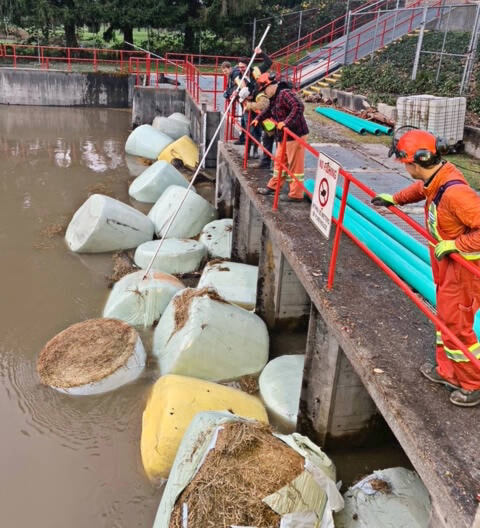Langley Township will consider installing a new pump where the Salmon River meets the Fraser, in the wake of November rainstorms that flooded fields, golf courses, and roads around Fort Langley.
At the Monday, Jan. 10 council meeting, council voted to analyse options, including additional pumping capacity, at the Salmon River Pump Station.
Originally put forward by Councillor David Davis, and approved at the Dec. 13 council meeting, the motion was brought up again for reconsideration by Coun. Kim Richter.
“I wish to amend it,” Richter said.
In the end, the project was changed to ensure that consultants working on the project would be familiar with environmental issues in floodplains. She also wanted to ensure local First Nations are consulted on any potential plans.
Davis supported reconsidering his own motion.
“I think these make it actually stronger,” he said of the changes.
READ ALSO: Families band together to clean up floating hay bale hazard
The motion does not mean a new pump will be installed, but the possibility will be investigated, given current regulations.
The debate came just after a longtime Langley environmentalist called for more “room to flood” for the Salmon River.
Stream advocate Doug McFee was one of the founding members of the Salmon River Enhancement Society more than 25 years ago, and on Monday, Jan. 10, he spoke to the Township council about the future of the waterway.
“We get floods frequently,” McFee noted, showing council photos from previous years of the fields around Fort Langley, which are often under water in the fall and winter months.
He spoke of the changes that have been made, including the Salmon River Pump Station, and various upgrades that have been made to the pumping and flood control measures in the region since 1995.
“It’s clear we can’t engineer our way out of the flooding,” McFee said. “We’ve tried that and it doesn’t work.”
The pumps where the Salmon River meets the Fraser River can pump about six cubic meters per second, but the river can flow at more than 40 cubic meters per second in the winter during heavy rain.
He said the problem is the local topography. The Salmon River in the area winds several miles from south east of Fort Langley to its confluence with the Fraser west of the village.
Over that whole area, the elevation is about three meters above the river level, McFee said.
“Water flows downhill,” he said. “There’s no real downhill going on here.”
He worried that pumping and dredging would simply harm fish habitat and kill young salmon. McFee suggested strategic purchases of land that could be allowed to flood to reduce the impact of future flood events, and running the pump station in a more ecologically friendly way.
During the floods in November, nearby roads such as 88th Avenue and Glover Road were partly under water. Plastic-wrapped hay bales floated off surrounding farm fields and drifted towards the pump station, and had to be rounded up.
READ ALSO: Langley drenched by downpour
Have a story tip? Email: matthew.claxton@langleyadvancetimes.com
Like us on Facebook and follow us on Twitter.
